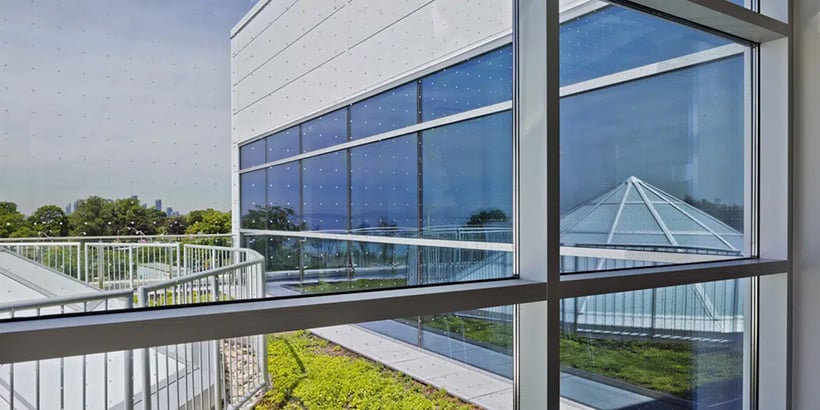As the interest in bird-safe windows and glazing applications grows, inquiries about tinted glass have become more frequent. Questions have emerged about the effectiveness of tinted windows for bird safety and the integration of bird-friendly glass on tinted substrates. This article delves into the world of tinted glass, particularly in the context of bird-friendly projects, providing a comprehensive examination of its advantages and considerations.
A special acknowledgment to Guernsey architects, Gensler architects, the Shashi Hotel, and Dr. Daniel Klem, Jr., Ph.D., D.Sc., for their valuable contributions to this article.
1. Why Use Tinted Glass?
The selection of tinted glass for windows encompasses numerous benefits, addressing various project requirements. Tinted glass effectively reduces glare and lowers Solar Heat Gain Coefficient (SHGC), enhancing interior comfort while reducing heating and cooling loads.1 Furthermore, the high reflectivity of the outer surface (surface one) ensures privacy for individuals within a building. This privacy feature is particularly advantageous for projects like schools, gyms, and hospitals, where safeguarding the well-being and privacy of users is a priority.
Illustrating this, the OVO Athletic Centre in Toronto (formerly known as the BioSteel Centre) is clad in Optiblue® glass by Vitro with bird-deterrent markers on surface one. This glass ensures privacy for the Toronto Raptors NBA team, who use the OVO Centre as their main training facility. In addition to providing privacy, the glass meets Toronto's Green Standard for bird deterrence. The blue tint, combined with its 2” x 2” bird-safe pattern, not only aligns with bird-friendly guidelines but also preserves design aesthetics, daylighting, and outdoor views.

The Ovo Centre in Toronto, ON
Glass: 6mm Optiblue® glass with AviProtek® pattern 215 on surface one
Photography credit: Philip Castleton
According to Lindsey McBride, Former Associate AIA, Guernsey, “Utilizing [acid-etched] bird-friendly glass allowed us to maximize views while achieving our privacy objectives, whereas other bird-friendly design options would have altered our building's design aesthetics. Building form, exterior shade devices, applied films, and fenestration patterns can be used to alter the bird's flight path; however, all of these methods result in a loss of natural lighting. Natural light is a necessary feature of high-quality design, and the bird-friendly pattern allows more flexibility in the design without limiting building form or envelope design.”
2. Are Tinted Glass Windows Better for Birds?
There’s a common concern about whether tinted glass is suitable for bird-safe windows. The answer: yes, if it’s done correctly.
On their own, tinted glass windows are not inherently beneficial for bird safety. In fact, the mirror-like quality of tinted glass can exacerbate reflections on the window surface, leading to a higher risk of bird collisions. According to Dr. Daniel Klem, Jr., Ph.D., D.Sc., “The level of reflection and its realistic expression on surface one can take place on a clear pane, but any light that’s occurring internal to a room that the pane covers will mitigate that reflection. But in the case of a tinted pane, it’s going to be harder and you’re going to have to use a brighter illumination to mitigate that image on the outside.”
In other words, tinted glass reflects the environment more than clear glass, and it’s more difficult to mitigate these reflections with interior lighting. To ensure bird safety when using tinted glass, it’s important to implement first-surface bird-friendly markers and adhere to best practices for bird-safe windows.
3. How to Ensure Bird Safety with Tinted Glass Windows?
Checklist for tinted glass in bird-safe applications:
- ✓ First-surface markers
- ✓ High-contrast patterning
- ✓ 2” x 4” or 2” x 2” spacing
- ✓ Durable surface treatment
Deterring bird strikes against tinted glass revolves around making the glass visible to birds just as it does with clear glass. This means interrupting the view through the glass and mitigating reflections on its surface. Several factors must be considered for projects incorporating bird-friendly tinted glass.
First-Surface Markers
Bird-friendly markers must be placed on the exterior surface (surface one) for optimal effectiveness. This is especially crucial on tinted glass, where reflections hinder markers on internal surfaces.
“Surface number one is a no-brainer. The pattern has to be there, and it has to be contrasting, and the more contrasting, the more effective.”
High-Contrast Patterning
Contrast is essential for markers to be visible to birds. On tinted glass, light-colored markers with minimal reflectivity are most effective. In fact, they can be even more effective on tinted glass substrates than on regular clear glass.
Standardized glass readings show that the contrast between acid-etched markers and background on bronze-tinted glass is even greater than on regular acid-etched bird-safe glass. That’s because the acid-etched area is pale and matte, while the surrounding tinted glass is significantly darker and much more reflective.
2” x 4” or 2” x 2” Spacing
It’s important to make sure that bird-deterrent markers are closely spaced across the entire surface of the glass. Applicable building standards may require 2” x 4” spacing or 2” x 2” spacing, depending on your project. You can learn more about these standards in the article, The 2×4 rule: The origin and definition
AviProtek® E bird-friendly patterns by Walker Glass are designed to meet these spacing guidelines. Please see the AviProtek® E product options to choose a pattern best suited to your project requirements.
Durable Surface Treatment
First-surface markers have to be tough to withstand UV rays, dirt, and general weathering. Acid-etched markers are etched into the glass itself, ensuring effective bird-deterrence year after year.
4. Do Bird-Friendly Glass Patterns Work on Tinted Windows?
This is the big question: do acid-etched markers on tinted glass really work?
They do.

Shashi Hotel, Mountain View, CA
Glass: 6mm Solarblue® glass with AviProtek® pattern 211 on surface 1, 6mm Optigray® glass with AviProtek® pattern 211 on surface 1
Photography credit: Ed Bartlett
Projects across North America, such as the Shashi Hotel in Mountain View, CA, showcase the success of bird-friendly markers on tinted glass. The Shashi Hotel, designed by Gensler, utilizes blue-tinted glass with a vertical stipe pattern to ensure both a striking visual appearance and bird safety.
The patterned glass, characterized by vertical stripes with variegated spacing up to 2” wide, not only acts as a bird deterrent but also contributes to the aesthetic harmony of the building. It’s a popular choice for zoos and nature centres, partly because the pattern’s density makes it one of the most effective products for bird deterrence. The Shashi windows were no exception. Agustin Sanchez, Director of Engineering at the Shashi Hotel, says, “I’m happy to report zero bird strikes. I think it's safe to say the bird-safe pattern works.”
Gensler’s approach to bird-friendly building follows the lead of nearby cities San Francisco and Palo Alto, as well as California’s voluntary bird-friendly design guidelines. These call for bird-deterrent patterns with 2” x 4” spacing in 90% of glazed areas in the first few stories. San Francisco and Palo Alto standards require treatment in the first 60’ from grade, while the California guidelines recommend treatment on the first 40’ from grade.
What to remember when using tinted glass in bird-friendly buildings
While tinted glass is not inherently bird deterrent, it can be an integral part of a successful bird-friendly building strategy when implemented correctly. Bird-friendly acid-etched markers are as effective on tinted glass as they are on clear glass. Furthermore, they contribute to bird safety without compromising the aesthetic appeal or natural lighting within a building.
The moral of the story: you can absolutely use tinted glass for bird-friendly buildings, as long as you implement best practices for bird-friendly glazing.
1 Source : ASTM C162
Updated on July 22, 2025




